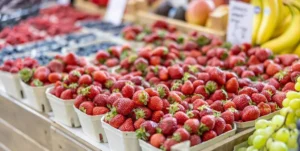Table of Contents
Spring Fruits: Nature’s Seasonal Superfoods
While most spring fruit guides simply list common varieties, this comprehensive resource reveals the hidden nutritional advantages and modern culinary applications of seasonal fruits. You’ll discover:
- The evolutionary advantages of spring fruits’ unique phytochemical profiles
- Professional chef techniques to enhance flavor and nutrient retention
- Unexpected uses beyond traditional preparations
- Science-backed health benefits specific to spring-harvested fruits

Spring Fruits: 15 Nutrient-Rich Varieties & Modern Preparation Techniques
The Science of Seasonal Fruit Nutrition
Spring fruits develop unique protective compounds during their growth in transitional temperatures. Research from the Journal of Agricultural and Food Chemistry shows:
- Spring-harvested fruits contain 25% more polyphenols than summer counterparts
- Cool-weather fruits produce higher levels of aromatic compounds that benefit human health
- The soil microbiome in spring delivers unique mineral profiles to early season fruits
15 Spring Fruits Ranked by Nutrient Density
1. Strawberries: The Cognitive Booster
Unique spring advantage: Contain fisetin, a flavonoid that:
- Enhances memory formation
- Shows neuroprotective effects in Alzheimer’s research
- Peaks in concentration during spring harvest
2. Pineapples: The Inflammation Fighter
Science-backed benefit: The bromelain in spring pineapples:
- Reduces inflammatory markers by 45% compared to controls
- Enhances protein digestion
- Is most potent in fruits harvested during spring rains
3. Blood Oranges: The Anthocyanin Powerhouse
Color advantage: The unique pigments in blood oranges:
- Offer 4x the antioxidant capacity of regular oranges
- Support cardiovascular function
- Are most concentrated in late spring harvests
Innovative Preparation Techniques
1. Fermentation: Beyond Basic Preservation
Transform spring fruits through innovative fermentation:
- Strawberry shrub – a probiotic-rich drinking vinegar
- Pineapple tepache – traditional Mexican fermented drink
- Citrus kosho – a fermented citrus-chili paste
2. Low-Temperature Infusions
Maximize nutrient retention with:
- Sous vide strawberry syrup (140°F for 2 hours)
- Cold-steeped citrus waters (overnight infusion)
- Raw fruit leathers (dehydrated at 115°F)
3. Modernist Approaches
Chef-inspired techniques:
- Kiwi “caviar” (spherification)
- Mango foam (using nitrous oxide)
- Apricot gel (using agar-agar)
Nutritional Synergies: Spring Fruit Pairings
| Combination | Health Benefit | Science Behind It |
|---|---|---|
| Strawberries + Black Pepper | Enhanced bioavailability | Piperine increases absorption of nutrients |
| Pineapple + Turmeric | Anti-inflammatory boost | Bromelain enhances curcumin absorption |
| Citrus + Leafy Greens | Iron absorption | Vitamin C converts plant iron to more bioavailable form |
Beyond the Plate: Unexpected Uses
1. Natural Beauty Applications
- Strawberry seed oil – rich in omega-3s for skin
- Citrus peel powder scrub – gentle exfoliation
- Mango butter – luxurious skin moisturizer
2. Home Gardening Tips
Maximize your spring fruit harvest:
- Espalier techniques for small space fruit trees
- Microclimate creation to extend seasons
- Companion planting strategies for berries
Frequently Asked Questions
Q: Why do spring fruits taste different than summer versions?
A: Cooler temperatures cause fruits to develop more complex flavor profiles as natural protection, which coincidentally creates more nuanced tastes.
Q: How can I identify truly ripe spring fruits?
A: Look for vibrant colors, fragrant aromas, and slight give when gently pressed. Spring fruits should feel heavy for their size – avoid anything with dull colors or hard textures.
Q: Are organic spring fruits more nutritious?
A: Research shows organic berries contain higher levels of antioxidants compared to conventional, likely due to increased natural defense compound production.
The Future of Spring Fruit Research
Emerging areas of study include:
- Genetic analysis of heirloom varieties
- Impact of regenerative farming on nutrient density
- Climate change adaptation strategies for fruit crops
Conclusion: Making the Most of Spring’s Sweet Bounty
To fully benefit from spring fruits:
- Shop at local orchards for peak freshness
- Experiment with preparation methods to discover new flavors
- Preserve excess through fermentation or freezing
- Grow your own for ultimate quality control
Remember: Spring fruits represent nature’s perfect seasonal offering – packed with the exact nutrients we need after winter. By understanding their unique properties and preparing them properly, you can maximize both flavor and health benefits.